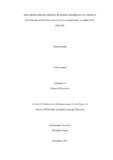
Please use this identifier to cite or link to this item:
https://hdl.handle.net/20.500.14301/115| Title: | EXPLORING STRATEGIES FOR TEACHING GRAMMATICAL ITEMS IN SECONDARY ENGLISH LANGUAGE CLASSROOMS: A NARRATIVE INQUIRY |
| Authors: | Sanba, Santosh |
| Citation: | Sanba.S(2021).Master of Philosophy in English Language Education presented at School of Education. |
| Issue Date: | Dec-2021 |
| Publisher: | School of Education |
| School: | SOED |
| Level: | M.Phil. |
| Abstract: | Teaching is a process of how we teach and what our students learn to the proposed knowledge and skills. This study explores the strategies employed for teaching grammatical items in the context of Nepalese secondary English language classrooms. Moreover, this research aims to explore in what ways language teachers teach and contextualize teaching grammar, and what different kinds of strategies they employ while teaching grammatical items. In doing so, I envisaged my study incorporating a thorough review of relevant, and resourceful literature about grammar teaching. The review of recent works of literature has helped me to strengthen my research agenda on teachers' strategies in teaching grammatical items. My study is delimited to the case of teaching grammatical items in secondary English classrooms using examples and rules. The finding of the research is understanding the grammatical perspectives on the grammatical items and strategies to teach in the classroom constructively and practically. According to four participants from the four schools, teaching grammar needs context and tasks with grammatical concept. I have adopted narrative inquiry as my research method to generate information from the four participants about their language teaching experiences and expertise in the Nepalese secondary English classrooms. A critical and closer examination of the narratives indicates that teachers enhance grammatical competence by contextualizing various methods of teaching grammatical items; however, they are scaffoldings of teachers’ experiences. My ontological, epistemological, and methodological standpoints were rooted in the interpretive paradigm. The collected information using narrative inquiry was a data generation approach which helped me to raise the teachers’ viewpoints, belief systems, and opinions. I was conscious, therefore, I appreciated their views, stories, opinions, and practices. expertise in the Nepalese secondary English classrooms. A critical and closer examination of the narratives indicates that teachers enhance grammatical competence by contextualizing various methods of teaching grammatical items; however, they are scaffoldings of teachers’ experiences. My ontological, epistemological, and methodological standpoints were rooted in the interpretive paradigm. The collected information using narrative inquiry was a data generation approach which helped me to raise the teachers’ viewpoints, belief systems, and opinions. I was conscious, therefore, I appreciated their views, stories, opinions, and practices. The four participants having a long English teaching experience were selected from the Lalitpur district. In doing so, I developed the field texts through teachers’ narratives. With prior permission, their voices were recorded and later transcribed maintaining the ethics of research. The transcribed field texts were reconfirmed with the participants making a regular follow-up to maintain authenticity of my research. Teachers' narratives were helpful for me to develop the thematic understanding from my four participants. Hence, the generated data was interpreted based on the life experiences, ideas, and opinions related to teaching grammatical strategies. I used the theory of social constructivism to build a theoretical foundation in this research. The strategies of teaching grammar and grammatical items were found to be contextualized in diverse teaching-learning settings. The teachers had different perceptions and practices which were associated with the contextualization of teaching grammatical items. Classroom observation, in-depth-interview, and field notes were much more helpful to analyze the live experiences, perceptions, and opinions related to interpreting the rules, examples, and structures in teaching grammar. The teachers were found to be teaching English grammar consulting journal articles and browsing electric re/sources and reading textbooks. Most of the teachers use textbooks to teach grammatical items including subject, verbs, pronouns, adjectives, prepositions, articles, verbs, adverbs, and conjunctions, etc. The items required context, concept, practice, and drills to build fluency, accuracy, and meaning in context. Teachers contextualize mutual understanding, engagement in classroom learning, and examples-based teaching as the major techniques for enhancing their students in the various drills, and pattern practices. The study further found that the newspapers, poetry, novels, stories, diaries, travelogue, critics, journals, books, textbooks, portfolios, notes, and reports, etc. were some of the tenets and useful resources for grammar teachers in integrating accuracy and fluency in grammar teaching. Moreover, the EFL teachers were found to be employing two major strategies i.e., example-based and structure-based strategies mostly to teach grammatical items. They are found offering both structures and examples while teaching grammar in their classroom practices. Furthermore, it was found that the teachers' ways of teaching grammatical items were grounded with both explicit-implicit methods and strategies from the classroom observation and fieldwork. They have prior grammar expertise to teach Nepalese EFL students. In conclusion, it was revealed that most of the teachers taught employing similar strategies for teaching grammar, and teachers use the example-based, structure-based, textbook-based, task-based, and communicative strategies for teaching grammar in their language classrooms. Although they use meaningful strategies, and effective tools for offering students continuous grammatical assessment and grammar practices as per the level of students. For this, teachers’ planning, and attention to the students seem to be progressive, contextual, and imperative from the context of the learning environment. My research participants conceptualize the actual knowledge about grammar rules which enable teachers to deliver their content appropriately in the classroom teaching and learning. For them, grammatical well-being is to ensure to transfer the grammar knowledge effectively to the learners applying different strategies such as structure-based, task-based, example-based, participation-based, and project-based, etc. for meaningful and effective learning in the language classroom. |
| URI: | http://101.251.6.110:8080/handle/20.500.14301/115 |
| Appears in Collections: | Dissertation |
Files in This Item:
| File | Description | Size | Format | |
|---|---|---|---|---|
| Santosh Samba ELE .pdf | 1.43 MB | Adobe PDF |  View/Open |
Items in DSpace are protected by copyright, with all rights reserved, unless otherwise indicated.